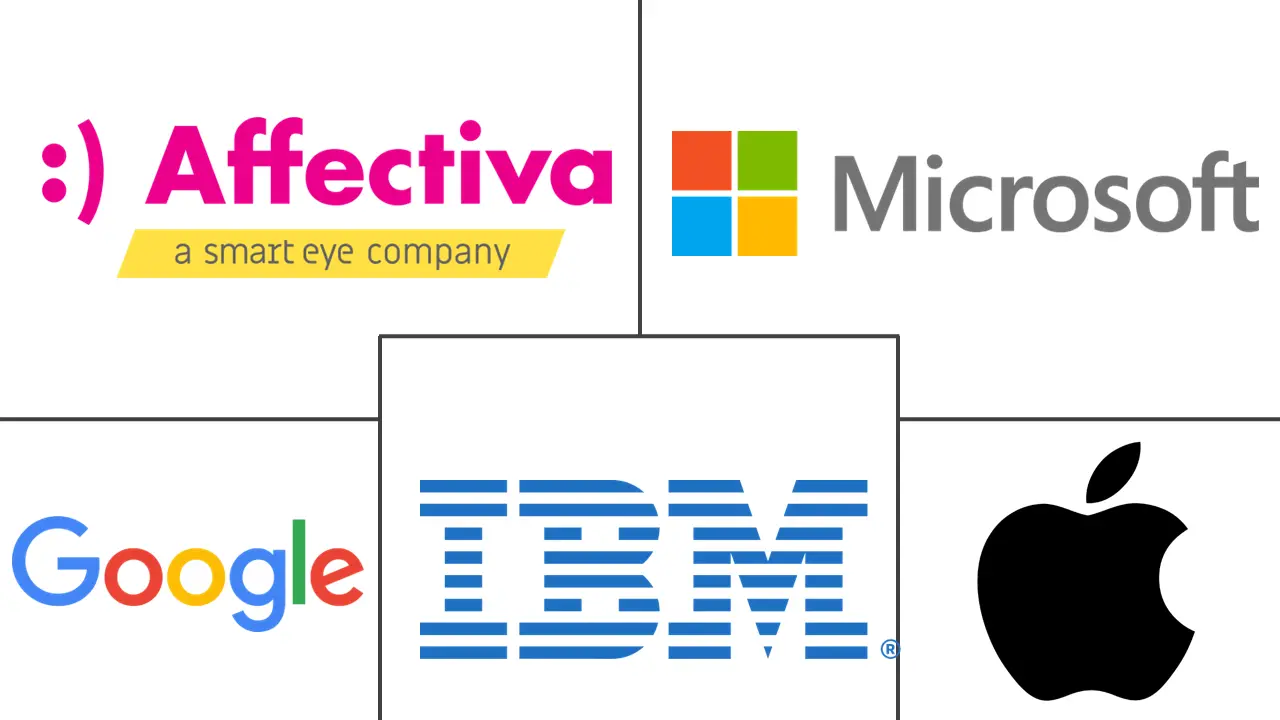Emotion Detection And Recognition (EDR) Market Size and Share
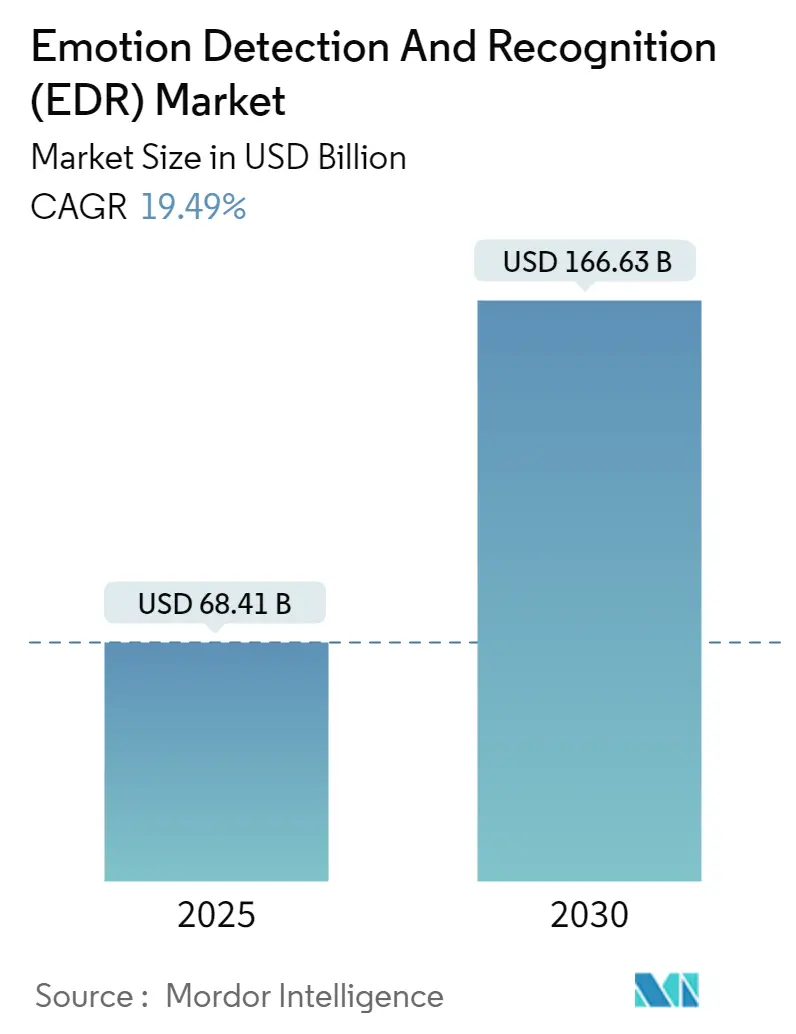
Emotion Detection And Recognition (EDR) Market Analysis by Mordor Intelligence
The Emotion Detection and Recognition market size is estimated at USD 68.41 billion in 2025 and is projected to reach USD 166.63 billion by 2030, growing at a 19.49% CAGR. This expansion reflects higher enterprise spending on AI-enabled personalization, regulatory mandates in automotive safety, and the rising availability of multimodal data sources that enhance algorithm accuracy. Machine learning advances shorten model-training cycles, while edge hardware investments reduce latency and cloud costs. Automotive OEM requirements for in-cabin monitoring create a stable demand floor that accelerates scale benefits for suppliers, while healthcare adoption of tele-mental health triage tools broadens use cases beyond surveillance. The Emotion Detection and Recognition market also benefits from growing speech-based biometric security deployments across banking and government, a surge in IoT-wearable integration that addresses privacy concerns associated with cameras, and expanding ecosystem partnerships between cloud vendors and niche emotion-AI specialists.
Key Report Takeaways
- By 2024, machine learning is expected to command a 42.5% share of the Emotion Detection and Recognition market size; meanwhile, biosensors are projected to advance at a 19.52% CAGR through 2030.
- By application, customer experience management led the Emotion Detection and Recognition market with a 27% share of the market size in 2024; automotive driver monitoring is poised for the fastest 19.95% CAGR from 2024 to 2030.
- By end user, government agencies captured 31% of the Emotion Detection and Recognition market share in 2024, while healthcare providers posted a 20.02% CAGR through 2030.
- By 2024, facial expression analysis software tools are expected to retain a 38% share of the Emotion Detection and Recognition market size; gesture and posture recognition is anticipated to grow at a 19.53% CAGR over the forecast period.
- By geography, the Asia Pacific held a 34% market share in the Emotion Detection and Recognition market in 2024, while North America was projected to have the highest CAGR of 19.6% from 2024 to 2030.
Global Emotion Detection And Recognition (EDR) Market Trends and Insights
Drivers Impact Analysis
| Driver | (~ ) % Impact on CAGR Forecast | Geographic Relevance | Impact Timeline |
|---|---|---|---|
| Proliferation of IoT-enabled wearables | +3.2% | Global, with APAC leadership | Medium term (2-4 years) |
| Surge in demand for speech-based biometric security | +2.8% | North America and EU | Short term (≤ 2 years) |
| Rising need for personalized customer experience tools | +3.5% | Global, retail-focused regions | Medium term (2-4 years) |
| Automotive OEM mandates for in-cabin driver emotion monitoring | +4.1% | Europe, North America, China | Long term (≥ 4 years) |
| Integration of emotion AI into tele-mental-health triage platforms | + 2.9% | North America, EU, Australia | Medium term (2-4 years) |
| Edge-based multimodal analytics to avoid cloud-privacy penalties | +2.7% | EU, California, privacy-conscious regions | Short term (≤ 2 years) |
| Source: Mordor Intelligence | |||
Proliferation of IoT-Enabled Wearables
Continuous emotion tracking migrates from cameras toward wrist, ear, and head-worn devices that collect heart-rate variability, galvanic-skin-response, and motion data. Apple’s patent filings highlight mainstream interest in multimodal sensing that extends fitness wearables into emotional-wellness functions USPTO. Enterprises see value in fatigue detection for drivers, warehouse staff, and pilots, while insurers explore risk-based pricing tied to physiological stress. Regulatory acceptance is higher because face images are absent and data storage remains local, aligning with privacy statutes.
Surge in Demand for Speech-Based Biometric Security
Financial services and public-sector agencies integrate emotion recognition with voice authentication to flag coercion, stress, or deceit during transactions. Neural-network models surpass 85% accuracy across languages. Contact-center deployments lower fraud losses and shorten call-handling time, delivering quick ROI. Growth accelerates as pandemic-driven hygiene concerns keep demand for touchless authentication elevated.[2]EEE, “Transactions on Biomedical Engineering,” ieeexplore.ieee.org
Rising Need for Personalized Customer Experience Tools
Retailers and e-commerce platforms leverage emotion analytics to generate monetizable insights, increasing conversion rates by up to 25%. Real-time sentiment feeds into dynamic pricing, recommendation engines, and chatbots, replacing demographic segmentation with behavioral triggers. Media-streaming services track viewers' emotions to inform content investment, while hospitality firms tailor ambient lighting and music to match collective mood states.
Automotive OEM Mandates for In-Cabin Driver Emotion Monitoring
Euro NCAP safety rating criteria and Chinese EV brand differentiation prompt automakers to integrate emotion detection with drowsiness alerts. Integration extends to adaptive HVAC, lighting, and infotainment that respond to occupant mood.. Usage-based insurance models utilize emotional-state scores to refine risk, generating new revenue streams for data providers and telematics firms. Demand sustains silicon vendors specializing in low-power edge AI for cabin environments.
Restraints Impact Analysis
| Restraint | (~ ) % Impact on CAGR Forecast | Geographic Relevance | Impact Timeline |
|---|---|---|---|
| Data-privacy regulation tightening (GDPR, CCPA) | -2.1% | EU, California, global diffusion | Short term (≤ 2 years) |
| Accuracy bias across ethnic groups | -1.8% | Global – diverse markets | Medium term (2-4 years) |
| GPU supply constraints inflating total cost of ownership | -1.5% | Global | Short term (≤ 2 years) |
| Pending EU ban on real-time public facial emotion surveillance | -1.3% | EU – global spillover | Medium term (2-4 years) |
| Source: Mordor Intelligence | |||
Data-Privacy Regulation Tightening (GDPR, CCPA)
Explicit-consent mandates, data-localization rules, and algorithm-explainability clauses increase compliance costs for deployers, favoring established companies and slowing consumer-facing rollouts. Vendors respond by adopting federated learning and differential privacy, which can degrade model performance and extend deployment cycles. Product-design revisions toward on-device inference gain urgency to avoid cross-border transfers of biometric data.
GPU Supply Constraints Inflating Total Cost of Ownership
Chip shortages have raised GPU acquisition costs by up to 60% since 2022, squeezing margins for deployments that require on-premises inference. Lower-budget sectors, such as education and small retail, defer adoption or pivot to lower-accuracy CPU-based models. Hardware scarcity also accelerates investment in alternative AI accelerators, which fosters fragmentation in the inference-hardware stack and complicates software support.
Segment Analysis
By Software Tool: Facial Recognition Commands Wallet Share While Gesture Detection Accelerates
Facial expression recognition held a 38% share of the Emotion Detection and Recognition market size in 2024, reflecting the ubiquity of cameras and the maturity of vision models. Enterprise adoption spans retail analytics and marketing research. Yet growth moderates as privacy rules restrict public-space imaging. Gesture and posture recognition is expected to exhibit a forecasted 19.53% CAGR as organizations favor non-identifying signals to infer engagement or fatigue. The Emotion Detection and Recognition market continues to blend computer-vision libraries with skeletal-tracking modules inside edge devices for unobtrusive sensing. Speech and voice analysis captures call-center demand, while bio-sensing tools ride the wearable boom to penetrate healthcare and workplace-wellness ecosystems.[1]United States Patent and Trademark Office, “Patent Database Search,” patents.uspto.gov
Regulators are increasingly prioritizing physiological monitoring over face-based systems, which is boosting interest in multimodal fusion that combines galvanic skin response, heart rate variability, and respiratory data. Bio-sensing tools, though small today, enjoy higher accuracy in low-light or obstructed-face conditions and address fairness concerns. Vendors embed such analytics into smart headphones, watches, and vehicle seats. Cross-tool interoperability frameworks are emerging to enable enterprises to switch modalities without rewriting business logic, thereby reinforcing platform strategies across the Emotion Detection and Recognition market.
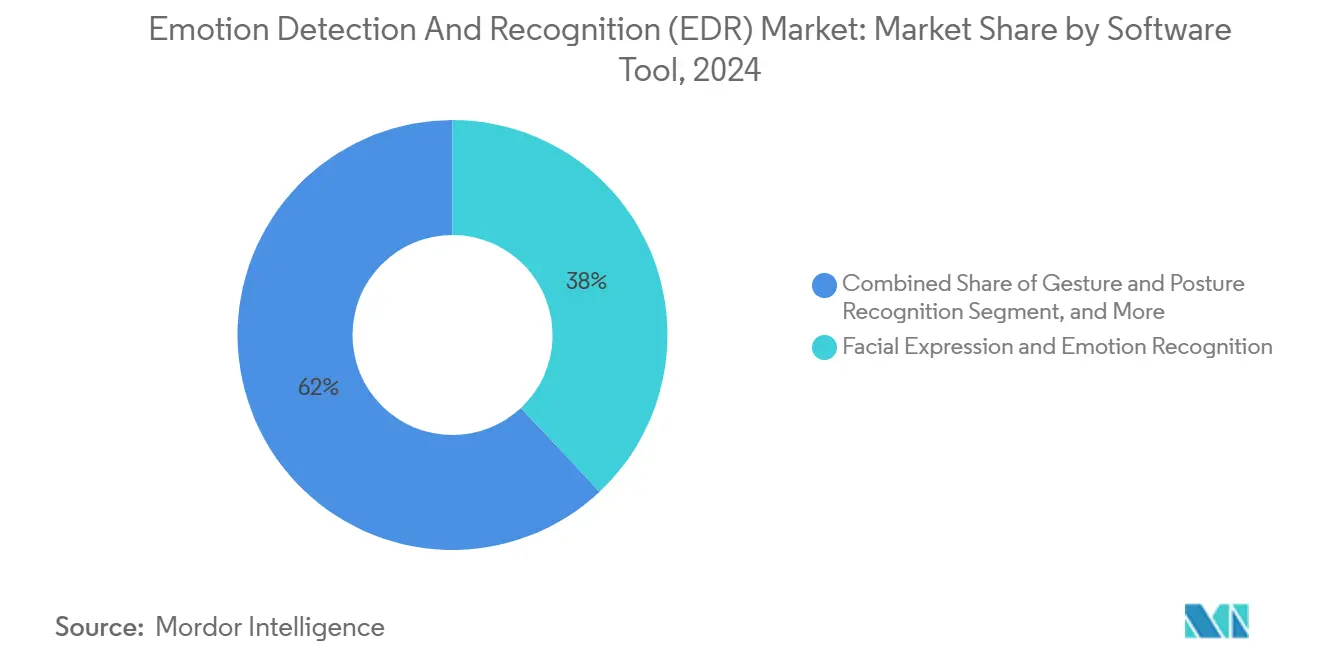
Note: Segment shares of all individual segments available upon report purchase
By Technology: Machine Learning Leads, Bio-Sensors Challenge Camera-Heavy Stacks
Machine learning technology accounted for 42.5% of the Emotion Detection and Recognition market share in 2024, driven by the maturity of its algorithms and the reusability of datasets across modalities. Transfer learning cuts time to deploy, while auto-ML tools democratize model building. Natural-language processing remains vital for text-centric sentiment analyses; computer vision persists for facial cues but faces regulatory drag. The Emotion Detection and Recognition market size associated with computer vision stacks grows more slowly as data protection agencies scrutinize facial analysis.
Bio-sensor technology is projected to post a 19.52% CAGR through 2030. Health systems adopt continuous monitoring to flag depressive episodes or post-surgical stress, aligning with tele-mental-health reimbursement policies, JMIR. Wearable device penetration supplies large labeled datasets that refine emotion-biomarker correlations, breaking the cold-start barrier. Regulatory leniency for physiological signals versus imagery supports this rise. Advanced sensor fusion enhances classifier confidence in noisy environments, thereby expanding its applicability to environments such as noisy factory floors and on-road settings. Edge-native chips capture data at the source, trimming cloud costs and appealing to privacy-first enterprises within the broader Emotion Detection and Recognition market.
By Application: Customer Experience Dominates, Automotive Accelerates Faster
Customer experience management is expected to own a 27% share of the Emotion Detection and Recognition market size by 2024. Retailers integrate real-time emotion scores into recommendation engines, customer journey mapping, and A/B tests for storefront displays. Conversion lifts of up to 25% underpin budget approval cycles. Hospitality and entertainment firms experiment with mood-responsive ambient environments that raise dwell time and repeat visits.
Automotive driver monitoring advances at a 19.95% CAGR, the fastest of any application, driven by Euro NCAP scoring and Chinese EV product differentiation. OEMs embed emotion trackers alongside existing eye-gaze sensors, combining drowsiness and aggression detection with comfort personalization. Insurers deploy emotion-driven risk scores for usage-based premiums, creating new data monetization channels. Healthcare applications are increasing steadily as telehealth workflows incorporate emotional metrics into triage, particularly for mental health screening during remote consultations. Law-enforcement surveillance occupies a niche but faces scrutiny; marketing analytics use cases are migrating to controlled panels where consent barriers are lower. These trends collectively expand the market for Emotion Detection and Recognition.
By End User Vertical: Government Budgets Anchor Demand, Healthcare Surges
Government agencies captured 31% of the Emotion Detection and Recognition market share in 2024 as public safety and border control bodies integrate emotion detection into behavioral analytics dashboards. Deterrence goals justify large multi-year contracts, insulating vendors from economic cycles. The retail and e-commerce sectors are continuing to rapidly roll out in-store sentiment cameras and online voice-analysis bots to reduce cart abandonment.
Healthcare providers are projected to post the fastest growth rate at a 20.02% CAGR. Post-pandemic telehealth platforms require scalable mental health triage that complements clinician shortages. Emotion-AI chatbots identify at-risk patients based on voice inflection or facial tension signals, as reported in JMIR. Hospitals integrate bedside camera feeds with vital signs to predict agitation and intervene early. Transportation firms adopt affect analytics for driver-fatigue mitigation; media companies refine content investments via viewer mood telemetry. Across sectors, the ISO 27001 and HIPAA frameworks are shaping vendor vetting as the Emotion Detection and Recognition market matures.
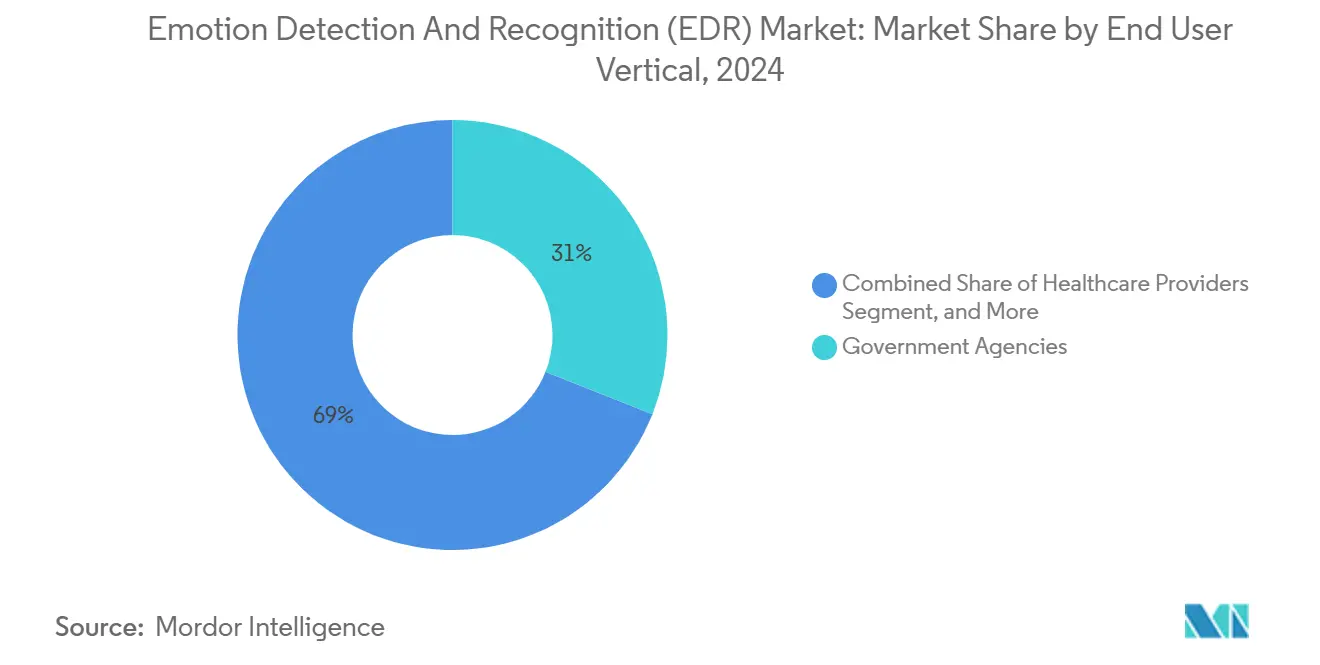
Note: Segment shares of all individual segments available upon report purchase
By Deployment Model: Cloud Retains Scale, Edge Gains Privacy-Driven Momentum
Cloud deployments dominate in aggregate seats but cede share to edge and on-premises models where data sovereignty or latency constraints are present. Healthcare and defense stakeholders route sensitive data streams through on-device inference engines to comply with GDPR and HIPAA mandates. Commercial off-the-shelf edge boxes now ship with optimized AI accelerators that process multimodal cues at <20 ms latency, enabling driver-safety and industrial-automation scenarios prohibitively slow in the cloud ACM.
Edge models also sidestep escalating GPU service fees. However, they demand upfront capital and specialized support teams. Cloud still excels in batch analytics, model retraining, and global rollout speed. Hybrid architectures emerge: raw sensing remains local, while anonymized features are synced to the cloud for aggregated learning. This bifurcated design anchors vendor roadmaps and influences buying criteria throughout the Emotion Detection and Recognition market.
Geography Analysis
Asia Pacific maintains a 34% share of the Emotion Detection and Recognition market, led by China’s large-scale surveillance infrastructure and Japan’s innovation in automotive HMIs. Government grants subsidize AI startup pilots in healthcare and smart city programs, while a comparatively permissive regulatory climate accelerates commercial deployments. South Korea leverages consumer electronics supply chains to embed emotion AI in smartphones and home appliances, while India’s IT services giants build export-oriented emotion analytics modules for U.S. clients.
North America ranks second in AI spending for emotional applications. U.S. retailers, banks, and tech platforms can quickly run pilot-to-production cycles, thanks to deep venture funding and mature cloud offerings. Healthcare growth accelerates under reimbursement codes for remote behavioral assessment. Canadian research groups partner with wearable firms to validate emotion biomarkers, reinforcing the region’s reputation for ethical AI frameworks even as CCPA-like state laws proliferate.
Europe experiences mixed momentum. GDPR compliance hurdles and looming AI-Act restrictions deter some public-space deployments. Yet, the continent leads in automotive driver monitoring due to safety regulations, and German Tier-1 suppliers funnel R&D into cabin-embedded sensors. Financial hubs in the United Kingdom are adopting voice-emotion analytics to flag potential fraud, capitalizing on the use of regulatory sandboxes. Privacy-preserving techniques, such as federated learning, flourish as vendors adapt to strict rules, influencing product designs exported worldwide. Collectively, these dynamics sustain a wide geographic dispersion of revenue within the Emotion Detection and Recognition market.
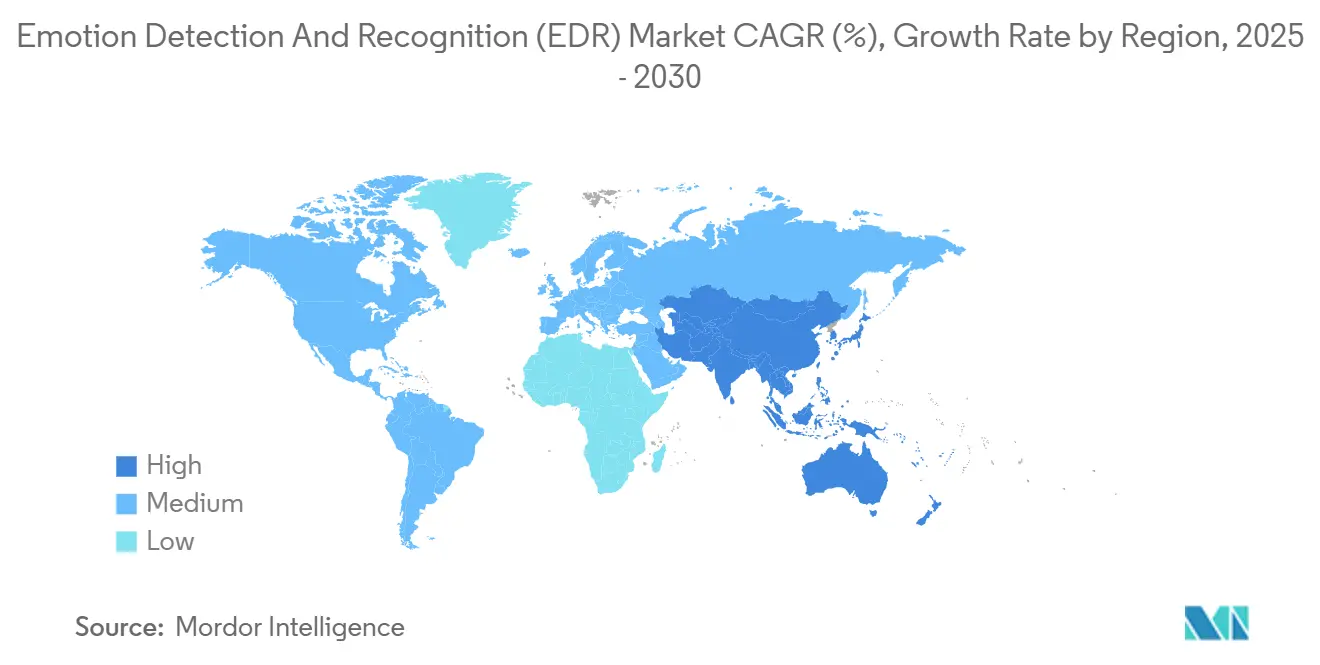
Competitive Landscape
The Emotion Detection and Recognition market exhibits a moderate concentration. Tech giants exploit cloud ecosystems to cross-sell emotion-AI APIs, embedding them into customer-experience suites and healthcare clouds. Specialized vendors retain an edge in modality-specific IP, such as eye tracking, vocal affect, or biosignal fusion. Acquisition activity underscores convergence: Smart Eye’s USD 73.5 million purchase of Affectiva folded emotion AI into driver-monitoring packages, enabling one-stop procurement for OEMs.[3]Smart Eye, “Smart Eye Completes Integration of Affectiva Technology,” smarteye.se
Cloud hyperscalers launched bias-mitigated emotion services with differential-privacy toggles, addressing enterprise procurement hurdles. Patent races intensify in multimodal fusion, with more than 300 new filings in 2024 referencing emotion analytics across at least two sensor types. Hardware entrants differentiate via low-power neuromorphic chips tailored for on-device affect inference, courting automotive and wearable OEMs. Regionally, Asian suppliers bundle emotion sensing with consumer-electronics firmware, while European specialists concentrate on automotive and industrial verticals. Moderate fragmentation leaves room for alliances, as customers increasingly favor end-to-end stacks in a more regulated Emotion Detection and Recognition market.
Emotion Detection And Recognition (EDR) Industry Leaders
-
Affectiva Inc. (Smart Eye)
-
IBM Corporation
-
Microsoft Corporation
-
Google LLC (Alphabet)
-
Apple Inc.
- *Disclaimer: Major Players sorted in no particular order
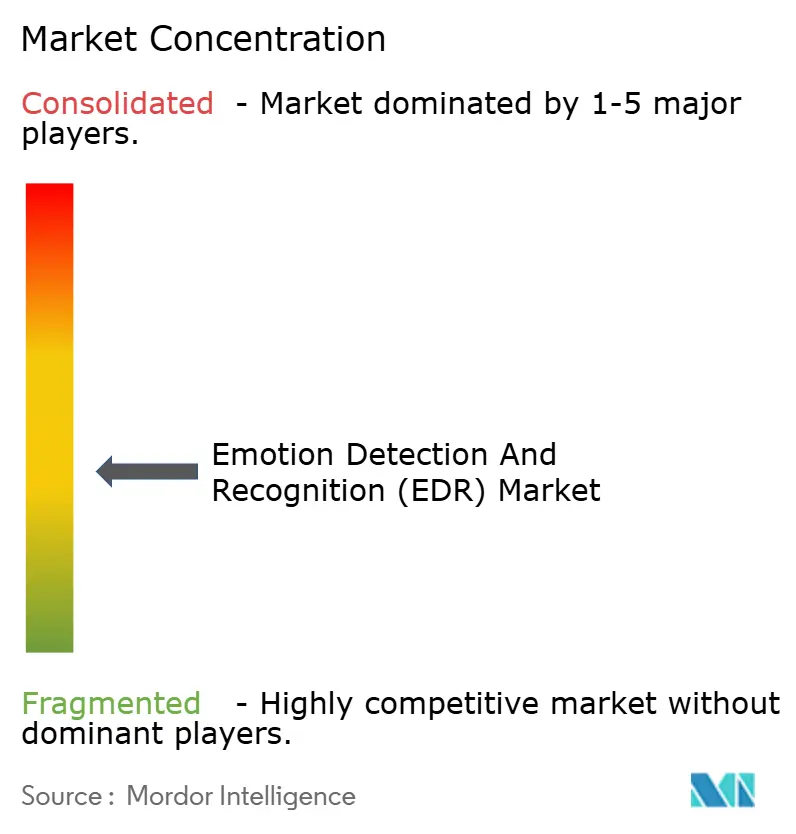
Recent Industry Developments
- January 2025: Microsoft added emotion analytics to Azure Cognitive Services, providing pre-trained facial and speech models for healthcare and customer-service scenarios.
- December 2024: Smart Eye finished integrating Affectiva’s technology into its driver-monitoring suite, creating the first combined drowsiness-emotion analysis platform for OEMs.
- November 2024: Apple filed patents covering voice and physiological emotion detection for Apple Watch and iPhone devices.
- October 2024: Amazon Web Services released Rekognition Emotion Detection with bias-mitigation and differential-privacy controls.
Global Emotion Detection And Recognition (EDR) Market Report Scope
Emotion detection recognition (EDR) is a method used for detection and recognition of human emotions with the incorporation of technological capabilities, such as facial recognition, speech and voice recognition, biosensing, machine learning, and pattern recognition. The study under consideration explores the global market for both EDR software and services that are capable of recognizing basic emotions (anger, contempt, disgust, fear, joy, sadness, and surprise).
The Emotion Detection and Recognition (EDR) Market is Segmented by Software and Services (Software (Facial Recognition, Speech and Voice Recognition, and Bio-sensing), Services), by End-user Vertical (Government, Healthcare, Retail, Entertainment, Transportation, Others), by Geography (North America, Europe, Asia Pacific, Rest of the World). The market sizes and forecasts are provided in terms of value in USD for all the above segments.
| Facial Expression and Emotion Recognition |
| Gesture and Posture Recognition |
| Speech and Voice Recognition |
| Bio-Sensing Software Tools |
| Machine Learning |
| Natural Language Processing |
| Computer Vision and 3-D Modeling |
| Bio-Sensors Technology |
| Customer Experience Management |
| Law Enforcement Surveillance and Monitoring |
| Healthcare and Medical Diagnostics |
| Automotive Driver Monitoring |
| Marketing and Advertising Analytics |
| Government Agencies |
| Healthcare Providers |
| Retail and E-Commerce |
| Media and Entertainment |
| Transportation and Logistics |
| Cloud |
| Edge and On-Premises |
| North America | United States |
| Canada | |
| South America | Brazil |
| Argentina | |
| Rest of South America | |
| Europe | Germany |
| France | |
| United Kingdom | |
| Italy | |
| Spain | |
| Russia | |
| Rest of Europe | |
| Asia Pacific | China |
| Japan | |
| India | |
| South Korea | |
| Rest of Asia Pacific | |
| Middle East | Saudi Arabia |
| United Arab Emirates | |
| Turkey | |
| Rest of Middle East | |
| Africa | South Africa |
| Nigeria | |
| Rest of Africa |
| By Software Tool | Facial Expression and Emotion Recognition | |
| Gesture and Posture Recognition | ||
| Speech and Voice Recognition | ||
| Bio-Sensing Software Tools | ||
| By Technology | Machine Learning | |
| Natural Language Processing | ||
| Computer Vision and 3-D Modeling | ||
| Bio-Sensors Technology | ||
| By Application | Customer Experience Management | |
| Law Enforcement Surveillance and Monitoring | ||
| Healthcare and Medical Diagnostics | ||
| Automotive Driver Monitoring | ||
| Marketing and Advertising Analytics | ||
| By End User Vertical | Government Agencies | |
| Healthcare Providers | ||
| Retail and E-Commerce | ||
| Media and Entertainment | ||
| Transportation and Logistics | ||
| By Deployment Model | Cloud | |
| Edge and On-Premises | ||
| By Geography | North America | United States |
| Canada | ||
| South America | Brazil | |
| Argentina | ||
| Rest of South America | ||
| Europe | Germany | |
| France | ||
| United Kingdom | ||
| Italy | ||
| Spain | ||
| Russia | ||
| Rest of Europe | ||
| Asia Pacific | China | |
| Japan | ||
| India | ||
| South Korea | ||
| Rest of Asia Pacific | ||
| Middle East | Saudi Arabia | |
| United Arab Emirates | ||
| Turkey | ||
| Rest of Middle East | ||
| Africa | South Africa | |
| Nigeria | ||
| Rest of Africa | ||
Key Questions Answered in the Report
What is the current value of the Emotion Detection and Recognition market?
The Emotion Detection and Recognition market size stands at USD 68.41 billion in 2025.
Which region leads spending on emotion AI solutions?
Asia Pacific holds the largest 34% revenue share, driven by China's AI infrastructure and Japan's automotive innovations.
Which application is growing fastest in emotion detection?
Automotive driver monitoring exhibits the highest 19.95% CAGR through 2030 due to safety mandates.
Why are bio-sensors gaining traction over facial recognition?
Bio-sensor approaches sidestep privacy concerns, meet healthcare compliance, and achieve robust emotion detection in low-light conditions.
How do privacy regulations affect adoption?
Statutes such as GDPR and CCPA impose explicit-consent and data-localization requirements, raising compliance costs and steering deployments toward edge processing.
What is the competitive outlook of the sector?
The market is moderately concentrated with strategic M&A; tech giants offer platform scale while niche vendors lead modality innovation.
Page last updated on:
